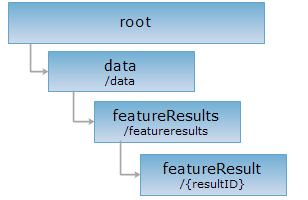<featureResults_uri>/{resultID}[.<format>]
The featureResult resource represents the data query result. It is created when implementing the POST request on the featureResult resource. You can get the feature collection information of the query result by implementing the GET request. The feature collection information includes the number of the features and the feature list. For the life cycle of the resource, see Life cycle of temporary resources.
Supported methods:
Supported output formats: RJSON, JSON, HTML, XML, GeoJSON.
Note: GeoJSON representation is available only when the type of queried feature is point, line or region.

Implement the HTTP request on the following URI, where supermapiserver is the server name, and 1 is the ID of the featureResult resource, and get the response in rjson format.
http://supermapiserver:8090/iserver/services/data-world/rest/data/featureResults/1.rjson
Gets the feature collection information contained in the query result.
None.
The structure of the response returned by implementing the GET request on the featureResult resource is as follows:
| Field | Type | Description |
| featureCount | int | The number of features. |
| featureUriList | List<String> | The URI list for features. |
Implement the GET request on the featuerResult resource with http://supermapiserver:8090/iserver/services/data-world/rest/data/featureResults/1.rjson and get the response in json format as shown below. Please see the POST request example of featureResults to know more about the query results in ID query mode.
{
"featureCount": 2,
"featureUriList": [
"http://supermapiserver:8090/iserver/services/data-world/rest/data/datasources/name/World/datasets/name/Capital/features/1",
"http://supermapiserver:8090/iserver/services/data-world/rest/data/datasources/name/World/datasets/name/Capital/features/2"
]
}
Asks for the response identical to the one that would correspond to a GET request, but without the response body. This is useful for retrieving meta-information written in response headers, without having to transport the entire content. The meta-information includes the media-type, content-encoding, transfer-encoding, content-length, etc.
The HEAD request helps check the existence of the featureResult resource and whether it can be accessed by the client. By implementing the HEAD request on the URI, with .<format> appended to the end, we can quickly get to know whether the featureResult resource supports the representation in <format> or not.